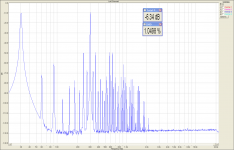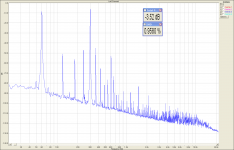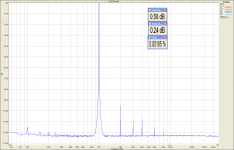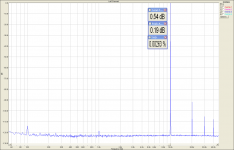Most I see here are all still for a flat amplifier with a non-linear transfer function not speakers.
That "Most" you are speaking about is 2/7, 2 tests of current total number of 7 are with mathematically added distortion, this makes 28.6%. I am not sure if 28.6% means "most". 5 tests of 7 are recorded directly from speaker. This has always been declared with every test provided.
For your convenience, below is the list of the tests provided in this thread so far
1) 1kHz sine at 4Vrms recorded from speaker
http://pmacura.cz/speaker1k.zip
2) 10kHz+12kHz twin tone IMD at 5.66Vpeak recorded from speaker
http://pmacura.cz/speaker10+12k.zip
This is a test on intermodulation, be careful not to use very high gain, because the test signals are in the top octave of human audibility range.
3) 2kHz sine recorded from speaker
http://pmacura.cz/speaker2k.zip
This was recorded 2 years ago and I believe that at 2.8Vrms, but I am not absolutely sure. However, the speaker under test has the highest level of distortion at about 2kHz, though distortion profile is different. That is the reason why this test was posted as well.
4) 100Hz sine recorded from speaker
http://pmacura.cz/speaker100.zip
5) Music sample with flute concert mathematically added distortion
http://pmacura.cz/flute.zip
6) As a preliminary test, here is a 30+300Hz IMD mathematically added distortion
http://pmacura.cz/30+300.zip
7) Intermodulation test 60+300Hz recorded from speaker
http://pmacura.cz/60+300_speaker.zip
30+300 was very easy:
60+300 was less easy but noticeable:
The more evident to me was in both cases the high freq tones added to the originals.
Code:
foo_abx 2.0.4 report
foobar2000 v1.3.16
2017-11-19 13:06:18
File A: 30+300_gen.wav
SHA1: 46e2a720a93cc936e3fed03e8336c2fa2646a957
File B: 30+300_gen distorted.wav
SHA1: 129ceea0ffba412913fc65244b5f53f0fc77cc2a
Output:
WASAPI (event) : Headphone (VIA HD Audio), 24-bit
Crossfading: NO
13:06:18 : Test started.
13:07:01 : 01/01
13:07:08 : 02/02
13:07:15 : 03/03
13:07:22 : 04/04
13:07:28 : 05/05
13:07:34 : 06/06
13:07:40 : 07/07
13:07:46 : 08/08
13:07:52 : 09/09
13:07:58 : 10/10
13:08:05 : 11/11
13:08:12 : 12/12
13:08:12 : Test finished.
----------
Total: 12/12
Probability that you were guessing: 0.0%
-- signature --
fa2204186cdbc9d64d6f9e88d9a54966388684ed
Code:
foo_abx 2.0.4 report
foobar2000 v1.3.16
2017-11-19 13:10:32
File A: 60+300_orig.wav
SHA1: 37bf250fcd70b6a84b52d440186a0f6731c1f250
File B: 60+300_rec.wav
SHA1: 66d8f817fd13fc59a7a8b87ace61e40e19c6e474
Output:
WASAPI (event) : Headphone (VIA HD Audio), 24-bit
Crossfading: NO
13:10:32 : Test started.
13:13:41 : 01/01
13:13:52 : 02/02
13:14:00 : 03/03
13:14:19 : 04/04
13:14:26 : 05/05
13:14:34 : 06/06
13:14:44 : 07/07
13:14:50 : 08/08
13:15:02 : 09/09
13:15:12 : 10/10
13:15:18 : 11/11
13:15:24 : 12/12
13:15:24 : Test finished.
----------
Total: 12/12
Probability that you were guessing: 0.0%
-- signature --
5f895c936501c085b7b4fa5e73797f0c0d79a202The high tones added seem stronger to me on the 30+300 test.
And, for me, the 60hz sine is more distracting than the 30hz.
I have done this test with MDR-V6 headphones.
This is absolutely correct. Please compare the spectra of 30+300Hz mathematically distorted file and 60+300Hz file recorded from the speaker. You will see that the 30+300 with math distortion has more and higher IMD components in the medium freq range, where the ear is most sensitive.
Attachments
I don’t know whether you have already covered this?
A) Wav.gen —> distortion software —> wav.math
B) Wav.gen —> DAC —> amplifier —> speaker —> mic —> preamp —> ADC —> wav.rec
In the case of B how are you controlling out everything but the speaker? For example, can you bypass speaker and mic and ensure no audible difference? Although this still includes the mic.
What components are you using? Perhaps stated on page 1: I’ll check.
A) Wav.gen —> distortion software —> wav.math
B) Wav.gen —> DAC —> amplifier —> speaker —> mic —> preamp —> ADC —> wav.rec
In the case of B how are you controlling out everything but the speaker? For example, can you bypass speaker and mic and ensure no audible difference? Although this still includes the mic.
What components are you using? Perhaps stated on page 1: I’ll check.
I don’t know whether you have already covered this?
A) Wav.gen —> distortion software —> wav.math
B) Wav.gen —> DAC —> amplifier —> speaker —> mic —> preamp —> ADC —> wav.rec
In the case of B how are you controlling out everything but the speaker? For example, can you bypass speaker and mic and ensure no audible difference? Although this still includes the mic.
What components are you using? Perhaps stated on page 1: I’ll check.
B - by measurements at speaker terminals, with the amp used in this test, I am below 0.002% of nonlinear distortion speaking about H2 and H3, higher harmonics negligible.
Re audibility, there was another test
Test your ears in my new ABX test
with much worse amplifier, the test was targeted on crossover distortion, and none of the participants was able to provide a positive ABX result when comparing a source file with the one recorded through path consisting of D/A, amplifier loaded with speakers and A/D. In case you are interested, please visit the linked thread. my apologies, I do not want to spend much time repeating everything that was already written. There were the tests not only with music, but with pure tones as well. As long as no one is able to give the proof of distinguishing any of the recorded files through the amp, I am not feeling like discussing the recording path.
4 ohm 32W 1kHz and 10kHz attached.
Attachments
Last edited:
Thanks Pavel. I have read most of that other thread (it's very long).
I think it is interesting how hard it was for observers to tell the difference between the source file and the sound sampled at the speaker terminals. This may be important.
We know that the music we perceive is very sensitive to each component in the chain. It is often easy to differentiate a cheap DAC from and expensive one, an optical vs coaxial SPDIF, digital cables, two amplifiers, tiny circuit changes within an amp, different capacitor dielectrics. So the test implication that the DAC/amp/speaker/ADC chain made no difference to listening to the original wav is uncanny.
I think it is interesting how hard it was for observers to tell the difference between the source file and the sound sampled at the speaker terminals. This may be important.
We know that the music we perceive is very sensitive to each component in the chain. It is often easy to differentiate a cheap DAC from and expensive one, an optical vs coaxial SPDIF, digital cables, two amplifiers, tiny circuit changes within an amp, different capacitor dielectrics. So the test implication that the DAC/amp/speaker/ADC chain made no difference to listening to the original wav is uncanny.
I don’t know whether you have already covered this?
A) Wav.gen —> distortion software —> wav.math
B) Wav.gen —> DAC —> amplifier —> speaker —> mic —> preamp —> ADC —> wav.rec
Pavel, again I'm sorry for not being able to follow all the files that have transpired. By speaker I meant B above also and hence my comment on not being able to create a perfect acoustically presented reference.
I do have a mic that measures <-60dB thirds only. You can measure the mic distortion in a couple of ways, the two speaker IM method or drive a very high Q closed chamber much smaller than a wavelength which will tend to contain pressure at only the fundamental.
- Status
- This old topic is closed. If you want to reopen this topic, contact a moderator using the "Report Post" button.
- Home
- Loudspeakers
- Multi-Way
- Audibility of speaker nonlinear distortion - test



